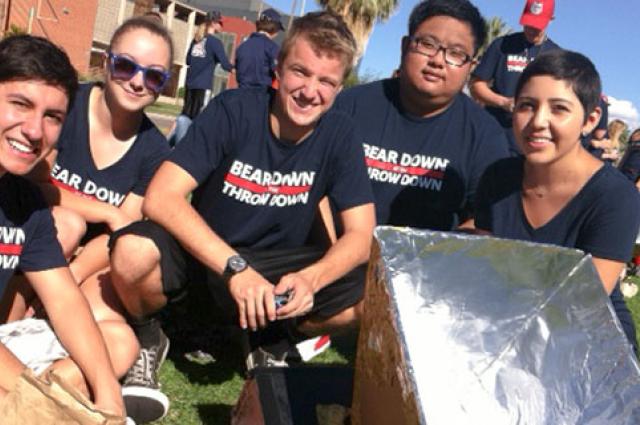Solar-Powered Ingenuity
The scene was sizzling on the UA Mall Oct. 21, when 450 freshmen positioned 100 hand-crafted solar ovens with foil reflectors and hunkered down to catch the sun’s rays.
But the Solar Oven Throw Down, now in its fifth year, wasn’t about getting a tan. It was the centerpiece of the College of Engineering’s introductory course ENGR 102, a dazzling display of first-year students’ mathematical modeling, engineering design and teamwork skills.
Ambient temperatures on the Mall that day reached 29.7 degrees Celsius (85 degrees Fahrenheit). But seeing how hot it would get -- inside or outside the ovens -- was not a priority for the students.
Their main challenge was to design an oven, build it as designed and then compare its performance -- particularly the temperature it would reach -- against that predicted using their mathematical model. This was an exercise in precision, not flash.
And precision ruled the day: The winning team, “Nerds-R-Us,” estimated that its oven would top out at 205 degrees Celsius (401 degrees Fahrenheit). And it did.
Teams competed within their sections on other criteria, including predicting the average temperature their ovens would reach and building the most cost-effective ovens.
Thinking Outside the Box
Teams of four to six students designed and built each solar oven, which is essentially a box within a box: a small boxy oven chamber for cooking a small bun, with foil-covered cardboard reflectors extending outward.
Students had many constraints in building the contraptions. Only common, low-cost materials could be used: cardboard, aluminum foil, Mylar sheets, duct tape and newspaper or construction paper, plus some optional ingredients. The cooking chamber was required to hold a specific volume and be within a certain size. And the reflector surfaces had to be straight rather than curved -- because bonfires were not permitted.
That still left considerable room for creativity, innovation and discovery.
The OVENgers used Styrofoam instead of paper for insulation, and the Alligators built an octagonal rather than four-sided reflector. Many teams expressed their whimsical sides through duct tape -- rejecting standard gray tape for tape of many colors, even macaroni-and-cheese-themed tape. One team draped its reflector with miniature flags representing members’ home countries.
Testing their Mettle
The Solar Oven Throw Down is the culmination of six weeks of hard work for the students. Though simple in appearance, the ovens require complex calculations and application of fundamental concepts in materials science, mechanical engineering and physics before they can take shape.
Slide Show
Following lessons on basic thermodynamics, students developed mathematical models on Excel spreadsheets to create a prediction model that would guide them in designing and building their oven and predicting its performance. For many students, it was their first experience designing and building a hands-on, functional product in a team.
While building the solar ovens is challenging and fun, it is the modeling component that is the most important part of the solar oven project, said Kathie Melde, ENGR 102 instructor.
“The idea of the solar oven project is for students to experience a bit about how engineers create models, test assumptions, review what worked and what didn’t and then improve. Engineers must do a lot of modeling, or simulation, and we want to be sure students can understand and apply modeling techniques.”
In the past, she said, the teams created their models collectively, and that often meant some students were taking a back seat. This year, each instructor required all of their students to complete modeling assignments individually.
After weeks of conducting research, poring over spreadsheets, and developing performance models, the teams built and carried prototype ovens out onto the Mall for a test run in early October. Then, it was back to the drawing board, to build new and improved ovens that would more closely match their intended designs and be ready for prime time a few weeks later.
Solar Ovens Are Serious Business
UA first-year engineering students have been designing and building solar ovens for years, said Brian Cunningham, ENGR 102 coordinator and lead instructor of the course. He and associate dean for academic affairs Jim Baygents started the Throw Down -- its name inspired by the Cooking Channel’s “Throwdown with Bobby Flay” -- in 2010 to give students a challenging, hands-on learning experience that would culminate in a large gathering where they could collaboratively share their work, build self-confidence and see firsthand how their math, modeling and engineering lessons could yield tangible, practical results.
This year, one of the instructors, Kasi Kiehlbaugh, put a new twist on the solar oven project to further inspire her students and demonstrate the value of their lessons. For the initial test of the prototype oven, she had students perform a water pasteurization test using a water pasteurization indicator and small jar of water.
“One of the main needs in developing countries is access to safe drinking water,” she said. “As my students learned firsthand, boiling is not necessary for pasteurization. A lot of fuel is wasted in bringing water to a boil unnecessarily.”
For the third consecutive year, the Solar Oven Throw Down was sponsored by technology company W.L. Gore & Associates. Representatives from Gore’s medical products division in Phoenix attended the event to talk shop with students and select a winner for Gore’s All-in-the-Same-Boat Award, recognizing outstanding teamwork. This year’s winner was “US-Be-Engineers.”
Winning Teams
Highest Performance Index Winner:
“Nerds-R-Us”
Instructor: Brian Cunningham
Predicted and Actual Temperature: 205 degrees Celsius
Casey Cadenhead
Joey Padish
Marcos Samayoa
Nicholas Varin
Gore All-in-the-Same-Boat Award Winner:
“US-Be Engineers"
Instructor: Ted Trouard
Anahi Aradai Herrera
Mark Jimenez
Leah Rose Kaplan
Stephen Jongwon Lee
Rebecca Rose Naldo
Sara Elizabeth Slosky


